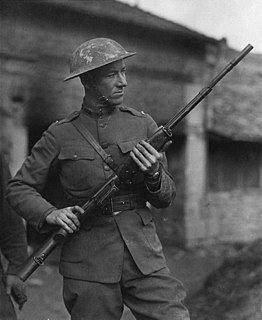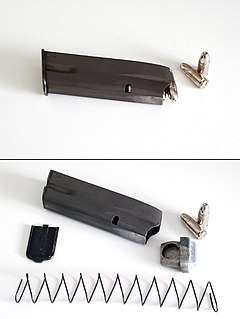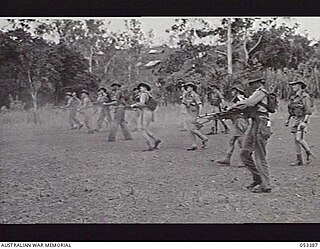
A semi-automatic rifle is an autoloading rifle that fires a single cartridge with each pull of the trigger, and uses part of the fired cartridge's energy to eject the case and load another cartridge into the chamber. For comparison, a bolt-action rifle requires the user to cycle the bolt manually before they can fire a second time, and a fully automatic rifle fires continuously until the trigger is released.

A squad automatic weapon (SAW), also known as a section automatic weapon or light support weapon (LSW), is a man-portable automatic firearm attached to infantry squads or sections as a source of rapid direct firepower. Weapons fulfilling this role can be light machine guns, or modified selective-fire rifles fitted with a heavier barrel, bipod and a belt/drum-fed design.

The M1 Garand or M1 rifle is a semi-automatic rifle that was the service rifle of the U.S Army during World War II and the Korean War.
A fireteam or fire team is a small military sub-subunit of infantry designed to optimize "bounding overwatch" and "fire and movement" tactical doctrine in combat. Depending on mission requirements, a typical fireteam consists of four or fewer members: an automatic rifleman, a grenadier, a rifleman, and a designated team leader. The role of each fireteam leader is to ensure that the fireteam operates as a cohesive unit. Two or three fireteams are organized into a section or squad in co-ordinated operations, which is led by a squad leader. Historically, nations with effective fireteam organization have had a significantly better performance from their infantry units in combat than those limited to operations by traditionally larger units.

The M1 carbine is a lightweight semi-automatic carbine that was a standard firearm for the U.S. military during World War II, the Korean War and the Vietnam War. The M1 carbine was produced in several variants and was widely used by paramilitary and police forces around the world, and also became a popular civilian firearm after World War II.

An autocannon, automatic cannon or machine cannon is a fully automatic gun that is capable of rapid-firing large-caliber armour-piercing, explosive or incendiary shells, as opposed to the smaller-caliber kinetic projectiles (bullets) fired by a machine gun. Autocannons have a longer effective range and greater terminal performance than machine guns, due to the use of larger/heavier munitions, but are usually smaller than tank guns, howitzers, field guns or other artillery. When used on its own, the word "autocannon" typically indicates a non-rotary weapon with a single barrel. When multiple rotating barrels are involved, such a weapon is referred to as a "rotary autocannon" or occasionally "rotary cannon", for short.
The M14 rifle, officially the United States Rifle, Caliber 7.62 mm, M14, is an American selective fire battle rifle chambered for the 7.62×51mm NATO cartridge. It became the standard-issue rifle for the U.S. military in 1959, replacing the M1 Garand rifle in service with the U.S. Army by 1958 and the U.S. Marine Corps by 1965. The M14 was used by the U.S. Army, Navy, and Marine Corps for Basic and Advanced Individual Training (AIT) from the mid-1960s to the early 1970s.

An automatic rifle is a type of autoloading rifle that is capable of fully automatic fire. Automatic rifles are generally select-fire weapons capable of firing in semi-automatic and automatic firing modes. Automatic rifles are distinguished from semi-automatic rifles in their ability to fire more than one shot in succession once the trigger is pulled. Most automatic rifles are further subcategorized as battle rifles or assault rifles.

This article is about the weapons used in the Vietnam War, which involved the People's Army of Vietnam (PAVN) or North Vietnamese Army (NVA), National Liberation Front for South Vietnam (NLF) or Viet Cong (VC), and the armed forces of the China (PLA), Army of the Republic of Vietnam (ARVN), United States, Republic of Korea, Philippines, Thailand, and the Australian, New Zealand defence forces, and a variety of irregular troops.

A magazine is an ammunition storage and feeding device for a repeating firearm, either integral within the gun or externally attached. The magazine functions by holding several cartridges within itself and sequentially pushing each one into a position where it may be readily loaded into the barrel chamber by the firearm's moving action. The detachable magazine is sometimes colloquially referred to as a "clip", although this is technically inaccurate since a clip is actually an accessory device used to help load ammunition into a magazine.

The ArmaLite AR-15 is a select-fire, gas-operated, air-cooled, magazine-fed rifle manufactured in the United States between 1959 and 1964. Designed by American gun manufacturer ArmaLite in 1956, it was based on its AR-10 rifle. The ArmaLite AR-15 was designed to be a lightweight rifle and to fire a new high-velocity, lightweight, small-caliber cartridge to allow infantrymen to carry more ammunition.

A battle rifle is a service rifle chambered to fire a fully powered cartridge. The term "battle rifle" is a retronym created largely out of a need to better differentiate the intermediate-powered assault rifles from full-powered rifles as both classes of modern firearms have a similar appearance and share many of the same features such as detachable magazines, pistol grips, separate upper and lower receivers etc. Battle rifles were most prominent from the 1940s to the 1970s, when they were used as service rifles. While modern battle rifles largely resemble modern assault rifle designs, which replaced battle rifles in most roles, the term may also describe older military full-powered semi-automatic rifles such as the M1 Garand, SVT-40, Gewehr 41, Gewehr 43, Type 4, FN Model 1949, and MAS-49.

The two most common rifles in the world are the Soviet AK-47 and the American M16. These Cold War-era rifles have been used in conflicts both large and small since the 1960s. They are used by military, police, security forces, revolutionaries, terrorists, criminals and civilians alike and will most likely continue to be used for decades to come. As a result, they have been the subject of countless comparisons and endless debate.

Infantry tactics are the combination of military concepts and methods used by infantry to achieve tactical objectives during combat. The role of the infantry on the battlefield is, typically, to close with and engage the enemy, and hold territorial objectives; infantry tactics are the means by which this is achieved. Infantry commonly makes up the largest proportion of an army's fighting strength, and consequently often suffers the heaviest casualties. Throughout history, infantrymen have sought to minimise their losses in both attack and defence through effective tactics.
The M1941 Johnson Rifle is an American short-recoil operated semi-automatic rifle designed by Melvin Johnson prior to World War II. Although the M1941 was used in limited numbers by the US Marines during the Second World War, it unsuccessfully competed with the contemporary M1 Garand rifle.

VC and PAVN battle tactics comprised a flexible mix of guerrilla and conventional warfare battle tactics used by Viet Cong (VC) and the North Vietnamese People's Army of Vietnam (PAVN) to defeat their U.S. and South Vietnamese (GVN/ARVN) opponents during the Vietnam War.

An assault rifle is a selective fire rifle that uses an intermediate cartridge and a detachable magazine. Assault rifles were first put into mass production and accepted into widespread service during World War II. The first assault rifle to see major usage was the German StG 44, a development of the earlier Mkb 42. While immediately after World War II, NATO countries were equipped with battle rifles, the development of the M16 rifle during the Vietnam War prompted the adoption of assault rifles by the rest of NATO. By the end of the 20th century, assault rifles had become the standard weapon in most of the world's armies, replacing full-powered rifles and sub-machine guns in most roles. The two most successful modern assault rifles are the AK-47 and the M16 designs and their derivatives.

In military terminology, a rocket is a self-propelled, generally unguided, weapon-system powered by a rocket engine. Though used primarily as medium- and long-range artillery systems, historically rockets have also seen considerable use as air-to-surface weapons, some use as air-to-air weapons, and even as surface-to-air devices. Examples of modern surface-to-surface rocket systems include the Soviet BM-27 Uragan and the American M270 Multiple Launch Rocket System.

Marching fire, also known as walking fire, is a military tactic – a form of suppressive fire used during an infantry assault or combined arms assault. Advancing units fire their weapons without stopping to aim, in an attempt to pin down enemy defenders. Marching fire usually ends with an infantry charge to engage the enemy in close combat. The tactic requires ample ammunition and rapid-fire weapons. It differs from fire and movement in that the attacking force advances in unison rather than leapfrogging forward in alternating groups.
The "Stinger" was a customized field modification of the .30-caliber AN/M2 aircraft machine gun. The Stinger was a man-portable modification of the AN/M2 — primarily mounted by various contemporary US aircraft — to provide additional firepower to a platoon. A handful of these weapons were used during the Pacific Theater of World War II. Nicknamed as such due to its extremely high rate of fire which led to the weapon having "quite a sting", most of the Stinger's fame comes from its use by Medal of Honor awardee Corporal Tony Stein, who used it during the Battle of Iwo Jima to provide covering fire for his platoon mates. While often attributed as Stein's work, the Stinger was actually the brainchild of two marines, namely Sergeant Milan "Mel" J. Grevich and Private First Class John Lyttle.

















